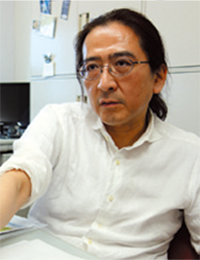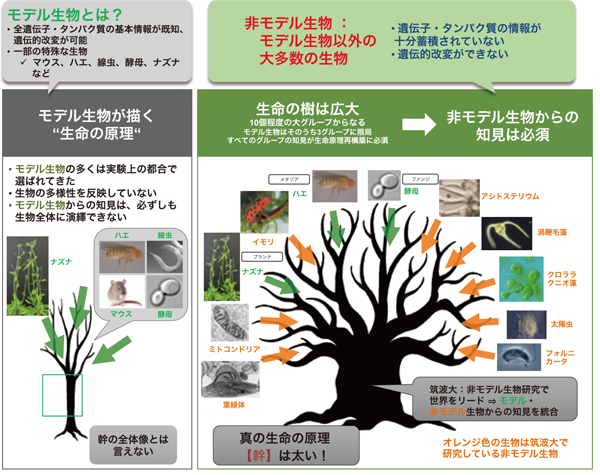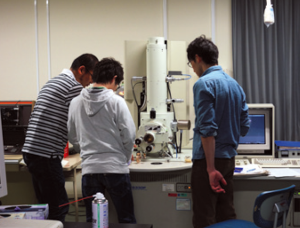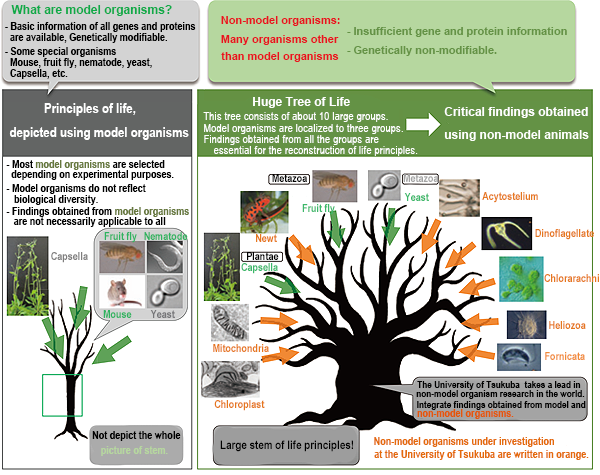他のメンバー : IRVING LOUIS JOHN 稲葉 一男 丸尾 文昭 岩井 宏暁 菊池 彰 宮村 新一 古川 純 佐藤 忍 坂本 和一 笹倉 靖徳 三浦 謙治 柴 小菊 小口 太一 小野 道之 沼田 治 石田 健一郎 千葉 親文 千葉 智樹 谷口 俊介 丹羽 隆介 中村 幸治 中田 和人 中野 賢太郎 中野 裕昭 渡邉 和男 堀江 健生 鈴木 石根 和田 洋 澤村 京一
キーワード: 基礎生物学、細胞機能、分子機構、進化系統樹
http://www.treeoflife-tsukuba.jp/

インタビュイー:橋本 哲男 教授
分子生物学的手法が身近になったおかげで、私たちは「ゲノム」という側面から多様な生命の全体像をとらえることが可能になってきました。これらの知識を用い、生命の根幹である細胞とその機能の進化を正しく理解すること、そして、得られた知識を改訂・再構築し新しい生命の基本原理=生命の樹の幹を導きだすことは、基礎生物学分野の最重要課題です。「生命の樹」リサーチユニットでは、普遍性と多様性の双方の面から進化に光をあて、その実態を浮き彫りにすることで、生命の基盤原理の展開と再構築に挑戦しています。
ミトコンドリアの本当の能力って何だろう?

図1:生命の樹(=全生物の系統樹)の概念図
本リサーチユニットは基礎生物学の研究拠点として活動するグループです。ユニットには、非モデル生物を対象に生物多様性について研究を行っているメンバー、モデル生物を用いて先端生命科学研究を行っているメンバー、生物情報解析を行っているメンバーなど生物学に関連する多数のメンバーが存在していますが、その誰もが「生命の樹」(図1)というコンセプトを軸に細胞機能の多様化プロセスの解明に取り組んできました。その結果わかってきたことは、「細胞機能には大きな多様性が存在する」と、いうことです。たとえば、モデル生物の研究から導かれてきた生命の基本原理のひとつに、ミトコンドリアは酸素呼吸を担う細胞小器官だ、という定説があります。しかし、私たちユニットメンバーの研究により、酸素呼吸をしない生き物ではミトコンドリアが持つ酸素呼吸能が退化してしまっている、ということがわかってきたのです。
モデル生物だけでは「生命の樹」は完成しない
酸素呼吸能を退化させてしまったミトコンドリアと酸素呼吸能をもつミトコンドリアの共通点を探索してみると、酸化還元反応の電子のやり取りに関与する鉄硫黄クラスターを作る、という能力はどちらももっていることが分かりました。つまり、全てのミトコンドリアに共通する機能は鉄硫黄クラスターの合成だということです。このように、モデル生物に共通する現象から構築されてきた定説に、非モデル生物から得た新たな細胞機能とその進化に関する知見を集積することで、基本原理(生命の樹の幹)の改訂・再構築を積極的に行っていきたいと考えています。また、個別の生物の生命現象や細胞構造の把握(図2)に留まらず、比較解析の基礎となるゲノムやトランスクリプトームの配列データの取得、オミックス解析*1 にも注力していく予定です。
*1:オミックス解析:遺伝子の発現(トランスクリプトーム)、たんぱく質の発現(プロテオーム)、SNP の同定、細胞内の全代謝物質の網羅的解析(メタボローム)等、個々の分子情報を網羅的に調査し、種々の分子情報の差異と共通性に基づいて全体性の把握に努めようとする研究分野のこと。

図2:細胞の構造把握に欠かせない電子顕微鏡を使った実験の様子
社会への貢献・実績
- ミオスタチン抑制剤の開発
- 植物におけるアレルゲン大量生産に関わる基盤研究
- エイズ日和見原虫感染症に対する新規薬剤標的の探索と生理機能の解明
取材:平成26年6月6日
Explore the life principles of whole organisms
Unit members : Louis John, Irving Inaba, Kazuo Maruo, Fumiaki Iwai, Hiroaki KIKUCHI, Akira Miyamura, Shinichi Furukawa, Jun Satoh, Shinobu Sakamoto, Kazuichi Sasakura, Yasunori Miura, Kenji Shiba, Kogiku Oguchi Taichi Ono, Michiyuki Numata, Osamu ISHIDA, Ken-ichiro Chiba, Chikafumi Chiba, Tomoki Yaguchi, Shunsuke Niwa, Ryusuke Nakamura, Kouji Nakada, Kazuto Nakano, Kentaro Nakano, Hiroaki Watanabe, Kazuo Horie, Takeo Suzuki, Iwane Wada, Hiroshi Sawamura, Kyoichi
Unit name: Tree of Life Research Unit
Keywords: basic biology, cellular function, molecular mechanisms, phylogenetic tree

interviewee; Hashimoto, Tetsuo
Molecular biology techniques have been widely employed to depict the whole picture of various organisms based on their “genomes.” This picture facilitates correct understanding of the evolution of cells and their functions as the basic principles of life, and revises and reconstructs knowledge to establish new basic principles of life. This is the most important issue in the field of basic biology. Our research unit “Tree of Life” sheds light on evolution in terms of universality and diversity to reveal the actual situations of lives, thereby challenging to revise and reconstruct the basic principles of life.
What are real mitochondrial ability?
Our research unit acts as a research center for basic biology, with many members including those investigating biological diversity using non-model organisms, those engaged in cutting-edge life science research, and those conducting biological information analyses. All the members have been trying to elucidate the diversification process of cell functions under the concept of “Tree of Life” (Figure 1). As a result, we found a great diversity in cell functions. For example, as a basic principle of life, revealed using model organisms, mitochondria are cell organelles responsible for oxygen breathing. This is a dogma. However, we found that the oxygen breathing ability of mitochondria has degenerated in organisms that can live without oxygen breathing.

Figure 1: Conceptual view of the Tree of Life (= phylogenetic tree of whole organisms)
“Tree of Life” cannot be completed only with model organisms.

Figure 2: Electron microscopy essential for understanding cell structures
Mitochondria with an oxygen breathing ability and those with a degenerated oxygen breathing ability turned out to share an iron-sulfur clustering ability responsible for electronic exchange in redox reactions. Specifically, a function common to all mitochondria is the synthesis of iron-sulfur clusters. Thus, we would like to aggressively revise and reconstruct the basic principle, the stem of the tree of life, by adding findings about new cell functions and their evolution, obtained using non-model organisms, to the dogma established from phenomena common to model organisms. In addition, we would like to collect genome and transcriptome sequence data for comparative analysis, in order to conduct OMICSs data analysis*1.
*1: OMICSs data analysis: Global molecular data analysis, such as gene (transcriptome) and protein (proteome) expression analysis, SNP identification, and exhaustive analysis of all cellular metabolites (metabolome), to understand differences and similarities among molecular information.
Social contributions and achievements
- Development of myostatin inhibitors
- Basic research on the mass production of allergens in plants
- Identification of new drug targets for opportunistic protozoan infections in HIV and elucidation of their functions
Interviewed on June 6, 2014
